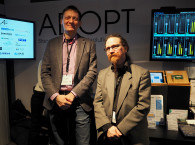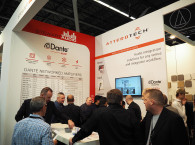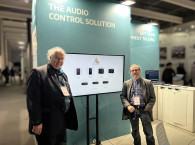
Speaking on the OCA Alliance’s booth, Chair of the Technical Working Group, Jeff Berryman testified to a sea change in industry-wide awareness and appreciation of the extensive capabilities of the open control standard, and the extent of possible solutions inherent in its specification: “Suddenly everybody knows what OCA is, and people have a whole breadth of ideas as to how they might want to implement it within particular applications and solutions."
The ‘A/V media control demonstration’, a collaboration between German automation company Beckhoff and OCA Alliance member company, d&b Audiotechnik, demonstrated integrated control of a d&b amplifier's volume, mute, and emergency paging functions, separate day and night modes, and auxiliary lighting systems. Beckhoff has recently added an OCA module to its extensive portfolio of PC control technology interfaces, and d&b Audiotechnik’s power amplifier range includes several OCA enabled models.
“The Beckhoff software allows the use of custom user interfaces with application-specific processing logic,” explains Berryman, “For the demo, it has been configured to control the amplifier's volume, mute, and emergency paging functions, and to provide separate day and night modes, and control auxiliary lighting systems.”

The same OCA initiative was being mirrored in a ‘real-life’ scenario, in the d&b demo room at ISE, illustrating the fully scalable control of audio, lighting and other systems for multi-use venues and multi-room applications. The ‘d&b system integration and interoperability’ session was conducted by Wolfgang Schulz, Product Manager for installation. “d&b became a founding member of the OCA Alliance at a very early stage,” he explains, “It was one of the first manufacturers to implement the open protocol into a product. The d&b solution portfolio now offers a high level of interoperability to integrate high performance audio with networking and control systems such as Beckhoff automation, QSC Q-SYS, Cestron, AMX and Peavey MediaMatrix. The downloadable amplifier modules and control scripts for these third party systems were developed by d&b in cooperation with the other manufacturers."
“Looking at the d&b solution for Beckhoff automation systems in more detail, the I/O system covers the entire range of actors and sensors, from standard digital and analog signals to the integration of lighting equipment, motion control, building automation and A/V media control. The automation platform simplifies control of d&b amplifier commands such as mute, change Power On/ Off status, check device status and recall AmpPresets (with all detailed settings used for a certain scenario). These parameters can be adjusted via the Beckhoff TwinCAT software using different Function Blocks for OCA communication. The OCA protocol implementation enables the d&b system to become part of a large automation platform. The complete system is designed, simulated and optimized and integrated during the installation, and can be controlled, monitored and operated intuitively by all users, for performances or applications of any kind.”

The second alliance booth demo highlighted web-based OCA control, in this case of an OCA MicroDemo device. A Safari web browser ran an OCA controller written in HTML5 and javascript, using the oca.js open-source javascript library from OCA Alliance member company DeusO GmbH. The controlled device – the OCA MicroDemo demonstration PC board – was co-developed by member companies Focusrite, Atterotech and Bosch.
The web page in the browser displayed a user interface that enabled responsive control of the physical lights and buttons of the MicroDemo. Control was bidirectional; touching buttons on the iPad screen changed the corresponding indicators on the MicroDemo, and pressing buttons and turning knobs on the MicroDemo caused corresponding display changes on the screen.
Matt Hardy is Business Development Manager at DeusO, the specialist web-based user interface developer for pro audio devices: “DeusO released the OCA.js JavaScript library, which is a complete controller implementation of the OCA (AES70) control protocol aimed primarily at audio applications, in May last year. This enables the development of web-based controllers for any OCA device, to run on all modern web browsers and support multiple simultaneous use from multiple control devices.”

Developed jointly by Archwave and Bosch, AudioLAN 2.0 provides an integrated technology platform utilizing AES67 for audio transport, and OCA (AES70) for discovery, connection management and device control. Together these two protocols provide new and unique benefits; users are able to view their entire audio system, send commands from device to device, and pass audio to anywhere in the network.
“Given the current growth in manufacturer interest,” concludes Berryman, “within the year there will be sufficient OCA product in the market for system designers and integrators to see OCA as an actual solution, not a prospective one. At ISE 2018, the OCA Alliance's message will reflect that proposition; for the first time we will bring the full OCA vision to the system design and install community.”
More About OCA
OCA (Open Control Architecture) is an open control and monitoring standard for professional audio and AV media network devices. From a single device and controller to networks with almost any number of devices and multiple controllers, OCA provides for powerful, high speed, low cost, robust system control and monitoring of devices from different manufacturers.
OCA can be used in conjunction with any available transport protocol (Dante, AVB, AES67, Cobranet, etc.). Offering interoperability across different media transports and manufacturers’ devices, it enables whole new levels of complex system integration and options as to how and where network devices can be deployed. The architecture operates on commodity Ethernet networking hardware or via standard 802.11 Wi-Fi.

Control functionality allows system professionals to change and monitor all operating parameters of a network device, including the creation and deletion of signal paths, parameter adjustments for signal processing objects, network device firmware updates and management of access control. Control can also be limited to provide simpler ‘operator’ functionality; for instance, providing just level, mute, power on/off and fault indication.
OCA has been ratified as an open public standard by the AES as AES70. OCA is not itself a media transport, or a means of programming a network device or system control, or generating a user interface. OCA is available free of charge to manufactures, system integrators and designers, to implement with their own and third party network devices, as they require.
ocaalliance.com






